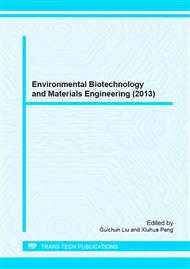[1]
H. M. Guo, Y. Li, K. Zhao, Arsenate removal from aqueous solution using synthetic siderite, J. Hazard. Mater. 176 (2010) 174-180.
DOI: 10.1016/j.jhazmat.2009.11.009
Google Scholar
[2]
Z.H. Ye, Z.Q. Lin, S.N. Whiting, M. De Souza, N. Terry, Possible use of constructed wetland to remove selenocyanate, arsenic, and boron from electric utility wastewater, Chemosphere. 52(2003) 1571-1579.
DOI: 10.1016/s0045-6535(03)00497-1
Google Scholar
[3]
A. S. Knox, M. H. Paller, E. A. Nelson, W.L. Specht, N.V. Halverson, J.B. Gladden, J. Environ. Qual. 35 (2006) 1948-(1959).
DOI: 10.2134/jeq2006.0017
Google Scholar
[4]
A. K. Kivaisi, The potential for constructed wetlands for wastewater treatment and reuse in developing countries: a review, Ecol. Eng. 16(2001) 545-560.
DOI: 10.1016/s0925-8574(00)00113-0
Google Scholar
[5]
Z. Song, Z. Zheng, J. Li, X. Sun, X. Han, W. Wang, M. Xu, Seasonal and annual performance of a full-scale constructed wetland system for sewage treatment in China, Ecol. Eng. 26(2006) 272-282.
DOI: 10.1016/j.ecoleng.2005.10.008
Google Scholar
[6]
P. Arroyo, G. Ansola, E. de Luis, Effectiveness of a full-scale constructed wetland for the removal of metals from domestic wastewater, Water. Air. Soil. Pollut. 210 (2010) 473-481.
DOI: 10.1007/s11270-009-0272-9
Google Scholar
[7]
H. Brix, C.A. Arias, The use of vertical flow constructed wetlands for on-site treatment of domestic wastewater: New Danish guidelines, Ecol. Eng. 25(2005) 491-500.
DOI: 10.1016/j.ecoleng.2005.07.009
Google Scholar
[8]
L. Q. Ma, K. M. Komar and C. Tu, A fern that hyperaccumulates arsenic, Nature 409 (2001): 579.
DOI: 10.1038/35054664
Google Scholar
[9]
H. Guo, Z. Zhong, M. Lei, X. Xue, X. Wan, J. Zhao, T. Chen, Arsenic Uptake from Arsenic-Contaminated Water Using Hyperaccumulator Pteris vittata L.: Effect of Chloride, Bicarbonate, and Arsenic Species, Water. Air. Soil. Pollut. 223(2012 a): 4209-4220.
DOI: 10.1007/s11270-012-1185-6
Google Scholar
[10]
S. Tu, L.Q. Ma, A.O. Fayiga, E.J. Zillioux, Phytoremediation of Arsenic-Contaminated Groundwater by the Arsenic Hyperaccumulating Fern Pteris vittata L. Int. J. Phytorem. 6 (2004) 35-47.
DOI: 10.1080/16226510490439972
Google Scholar
[11]
J.W. Huang, C.Y. Poynton, L.V. Kochian, M.P. Elless, Phytofiltration of arsenic from drinking water using arsenic-hyperaccumulating ferns, Environ. Sci. Technol. 38(2004) 3412-3417.
DOI: 10.1021/es0351645
Google Scholar
[12]
S. Natarajan, R. H. Stamps & L. Q. Ma, U.K. Saha, D. Hernandez, Y. Cai, E.J. Zillioux, Phytoremediation of arsenic-contaminated groundwater using arsenic hyperaccumulator Pteris vittata L.: Effects of frond harvesting regimes and arsenic levels in refill water, J. Hazard. Mater. 185(2011).
DOI: 10.1016/j.jhazmat.2010.10.002
Google Scholar
[13]
B. Zhang, J. Zheng, R. Sharp, Phytoremediation in engineered wetlands: Mechanisms and Applications. Procedia Environ. Sci. 2(2010) 1315-1325.
DOI: 10.1016/j.proenv.2010.10.142
Google Scholar
[14]
J. Zhao and H. Guo: Applied Mechanics and Materials, 295-298 (2013) 1139-1143.
Google Scholar


